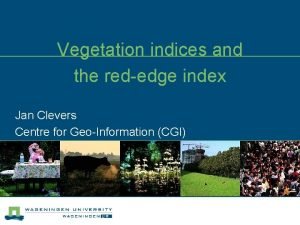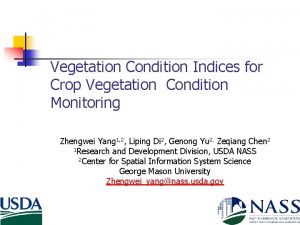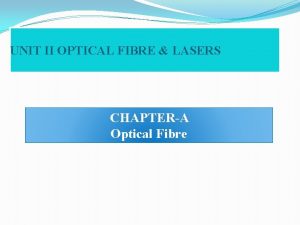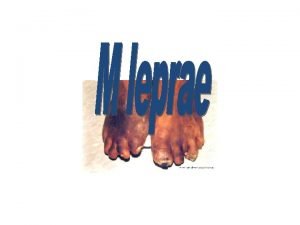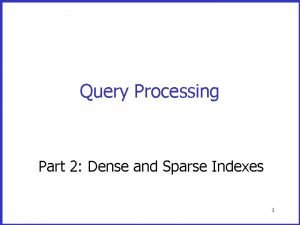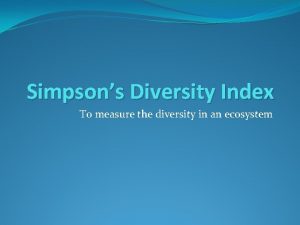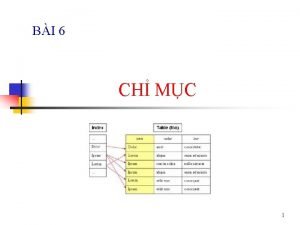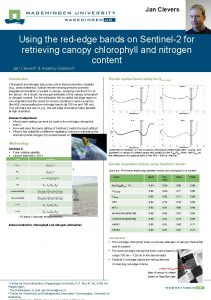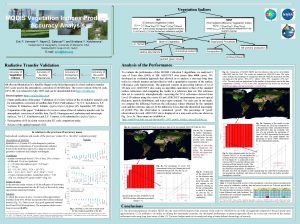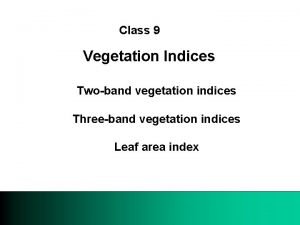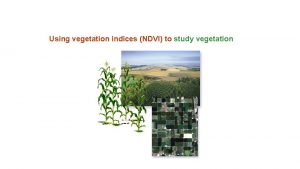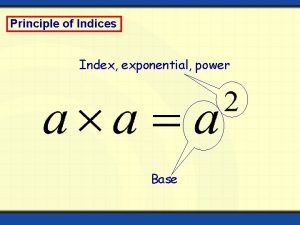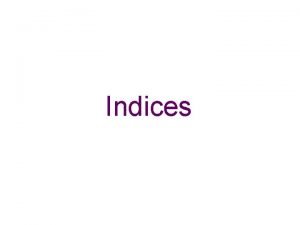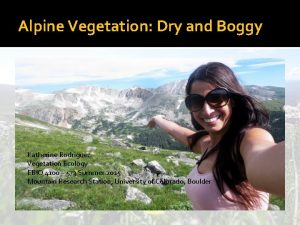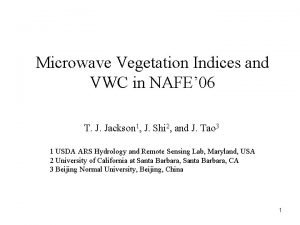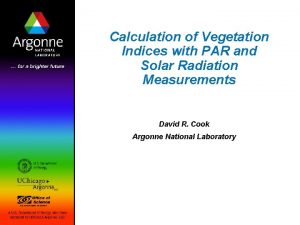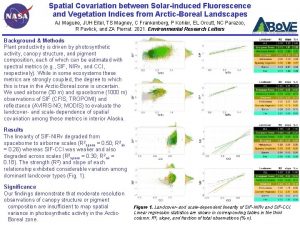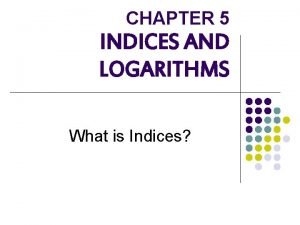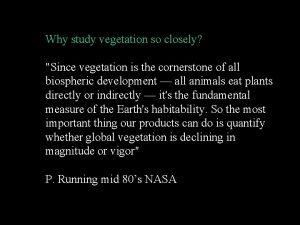Vegetation indices and the rededge index Jan Clevers







































- Slides: 39

Vegetation indices and the red-edge index Jan Clevers Centre for Geo-Information (CGI)

Quantitative Remote Sensing: The n Signatures: Spectral, Spatial, Temporal, Angular, and Polarization Classification n Statistical Methods l l n Physical Methods l l n Correlationships of land surface variables and remotely sensed data + Easy to develop, effective for summarizing local data - Models are site-specific, no cause-effect relationship Example: WDVI (Clevers, 1999), GEMI (Pinty and Verstraete, 1992) Inversion of [snow | canopy | soil] reflectance models + Follow a physical law, improvement through iteration - Long development curve, potentially complex Example: MODIS LAI (Myneni, 1999) Hybrid Methods l l Combination of Statistical and Physical Models Example: EO-1 ALI LAI (Liang, 2003) Source: Liang, S. , 2004 Centre for Geo-information

Vegetation Indices à strengthening the spectral contribution of green vegetation à minimizing n n n disturbing influences of: soil background irradiance solar position yellow vegetation atmospheric attenuation mostly utilizing a red (R) and NIR spectral band Centre for Geo-information

0 0. 2 0. 4 NIR 1. 0 0. 8 0. 6 Ratio-based Vegetation Indices NIR/R ratio (RVI) n NDVI = (NIR-R)/(NIR+R) (Normalized Difference VI) n NDVI 1 R 0 2à 3 LAI Centre for Geo-information

Orthogonal-based Vegetation Indices § Perpendicular VI (PVI): NIR 1/ (a 2+1) (NIR – a × R) soil line § Weighted Difference VI (PVI = 0) (WDVI): NIR – a × R § Difference VI (DVI): NIR – R R a = slope soil line Centre for Geo-information

Simplified reflectance model R = Rv × B + Rs × (1 – B) R : measured reflectance Rv : reflectance vegetation Rs : reflectance soil B : apparent soil cover Centre for Geo-information

Calculate WDVI Red: R = Rv × B + Rs × (1 – B) NIR: NIR = NIRv × B + NIRs × (1 – B) Assume: a = NIRs / Rs (slope soil line) The NIR signal coming from the vegetation only can be approximated by the WDVI: WDVI = NIR – a × R Centre for Geo-information

Hybrid Vegetation Indices § Soil Adjusted VI (SAVI): NIR (1 + L) × (NIR – R)/(NIR +R + L) L = l 1 + l 2 0. 5 R l 2 l 1 Broge & Leblanc, Remote Sens. Environ. 76 (2000): 156 -172 Centre for Geo-information

Enhanced Vegetation Index (EVI) for use with MODIS data n C 1 = atmospheric resistance red correction coefficient [6. 0] C 2 = atmospheric resistance blue correction coefficient [7. 5] n L = canopy background brightness correction factor [1. 0] n http: //tbrs. arizona. edu/project/MODIS/evi. php Centre for Geo-information

Use of vegetation Indices Estimation of: n Leaf Area Index (LAI) n Vegetation cover n Absorbed Photosynthetically Active Radiation (APAR) n Chlorophyll or nitrogen content n Canopy water content n Biomass n Carbon n Structure of the canopy Centre for Geo-information

Use of vegetation Indices Estimation of: n Leaf Area Index (LAI) n Vegetation cover n Absorbed Photosynthetically Active Radiation (APAR) n Chlorophyll or nitrogen content n Canopy water content n Biomass n Carbon n Structure of the canopy Centre for Geo-information

Red Edge Index Determining vegetation condition using RS: e. g. blue shift of the red edge as a result of stress 1 2 reflectance (%) 60 healthy with stress 40 20 0 0. 4 0. 5 0. 6 0. 7 0. 8 wavelength (µm) Centre for Geo-information

Calculation REIP Red edge inflection point (REIP) = Red edge position (REP) = Maximum of the first derivative. is maximum. Centre for Geo-information

PROSPECT – SAIL simulation Centre for Geo-information

Soil background influence Centre for Geo-information

Atmospheric influence Centre for Geo-information

Inverted Gaussian function Rs = shoulder reflectance Ro = minimum reflectance o = wavelength at Ro = Gaussian shape parameter Centre for Geo-information

Linear interpolation method Centre for Geo-information

Linear interpolation method Centre for Geo-information

REP image for MERIS Each digital number represents a wavelength value (being the REP) Centre for Geo-information

Chlorophyll Index (CI) CIred_edge = (RNIR / Rred_edge) – 1 = (R 780 nm / R 710 nm) – 1 As estimator of chlorophyll content Gitelson et al. , Geophysical Research Letters 33 (2006), 5 pp. http: //www. calmit. unl. edu/people/gitelson/ Centre for Geo-information

Photochemical Reflectance Index (PRI) PRI = (R 531 nm – R 570 nm) / (R 531 nm + R 570 nm) As estimator of photosynthetic activity Gamon et al. , Remote Sensing of Environment 41 (1992), 35 – 44. Centre for Geo-information

Use of vegetation Indices Estimation of: n Leaf Area Index (LAI) n Vegetation cover n Absorbed Photosynthetically Active Radiation (APAR) n Chlorophyll or nitrogen content n Canopy water content n Biomass n Carbon n Structure of the canopy Centre for Geo-information

Estimating Canopy Water Content (CWC) 970 nm 1200 nm Centre for Geo-information

Estimators for Canopy Water Content n n n Reflectances Continuum removal: MBD, AUC, ANMB Water band indices: WI, NDWI WI = R 900/R 970 NDWI = (R 860 – R 1240) / (R 860 + R 1240) n Derivatives Centre for Geo-information

Results: PROSPECT-SAILH simulation CWC Centre for Geo-information

Results: Millingerwaard 2004 - Field. Spec Centre for Geo-information

Summary PROSPECTSAILH Field. Spec 2004 Hy. Map 2004 Field. Spec 2005 AHS 2005 Derivative Left slope 0. 98 @ 942. 5 nm 0. 72 @ 936. 5 nm 0. 50 @ 936 nm 0. 55 @ 936. 5 nm 0. 56 @ 933 nm Derivative Right slope 0. 93 @1032. 5 nm 0. 34 @1031. 5 nm 0. 45 @ 1030 nm 0. 43 @1031. 5 nm -- WI 0. 94 0. 37 0. 38 0. 40 0. 41 NDWI 0. 86 0. 50 0. 25 0. 36 -- Centre for Geo-information

Continuum removal (1) Use Continuum Removal to normalize reflectance spectra to allow comparison of individual absorption features from a common baseline. The continuum is a convex hull fit over the top of a spectrum utilizing straight line segments that connect local spectra maxima. The first and last spectral data values are on the hull and therefore the first and last bands in the output continuum-removed data file are equal to 1. 0. (Source: ENVI online help) Convex hull Centre for Geo-information

Continuum removal (2) http: //speclab. cr. usgs. gov/PAPERS. refl-mrs/ Centre for Geo-information

Continuum removal (3) Centre for Geo-information

Continuum removal (3) MBD = Maximum Band Depth Centre for Geo-information

Continuum removal (3) AUC = Area Under Curve ANMB = Area Normalized by the Maximum Band depth Centre for Geo-information

Spectral unmixing aims at finding the fractions or abundances of end-members, which are spectrally pure by deconvolving them from a mixed spectrum Reflectance spectra Centre for Geo-information

Mathematics of linear unmixing Ri = reflectance of the mixed spectrum of a pixel in image band i ¦j = fraction of end-member j Reij = reflectance of the end-member spectrum j in band i i = the residual error n = number of end-members Constraining assumptions: and Centre for Geo-information

Spectral unmixing at Cuprite Alunite Calcite Kaolinite Silica Zeolite RMS image Geologic map from unmixing Centre for Geo-information

Problems with unmixing n n How to select the end members? Do these describe the data spectrally? Are these of interest? Is mixing a linear process? Spectral unmixing Centre for Geo-information

Spectral field measurements Centre for Geo-information

Questions ? www. scopus. com/home. url www. isiknowledge. com © Wageningen UR
 Jan clevers
Jan clevers Vegetation condition index formula
Vegetation condition index formula Optical fibre
Optical fibre Bacteriological index formula
Bacteriological index formula Limitations of pqli
Limitations of pqli Optical fiber waveguide
Optical fiber waveguide Consistency index
Consistency index Primary index is dense or sparse
Primary index is dense or sparse Simpson diversity index example
Simpson diversity index example Clustered index và non clustered index
Clustered index và non clustered index Hát kết hợp bộ gõ cơ thể
Hát kết hợp bộ gõ cơ thể Frameset trong html5
Frameset trong html5 Bổ thể
Bổ thể Tỉ lệ cơ thể trẻ em
Tỉ lệ cơ thể trẻ em Voi kéo gỗ như thế nào
Voi kéo gỗ như thế nào Tư thế worm breton là gì
Tư thế worm breton là gì Hát lên người ơi
Hát lên người ơi Các môn thể thao bắt đầu bằng tiếng bóng
Các môn thể thao bắt đầu bằng tiếng bóng Thế nào là hệ số cao nhất
Thế nào là hệ số cao nhất Các châu lục và đại dương trên thế giới
Các châu lục và đại dương trên thế giới Công thức tiính động năng
Công thức tiính động năng Trời xanh đây là của chúng ta thể thơ
Trời xanh đây là của chúng ta thể thơ Mật thư anh em như thể tay chân
Mật thư anh em như thể tay chân 101012 bằng
101012 bằng độ dài liên kết
độ dài liên kết Các châu lục và đại dương trên thế giới
Các châu lục và đại dương trên thế giới Thơ thất ngôn tứ tuyệt đường luật
Thơ thất ngôn tứ tuyệt đường luật Quá trình desamine hóa có thể tạo ra
Quá trình desamine hóa có thể tạo ra Một số thể thơ truyền thống
Một số thể thơ truyền thống Cái miệng nó xinh thế
Cái miệng nó xinh thế Vẽ hình chiếu vuông góc của vật thể sau
Vẽ hình chiếu vuông góc của vật thể sau Nguyên nhân của sự mỏi cơ sinh 8
Nguyên nhân của sự mỏi cơ sinh 8 đặc điểm cơ thể của người tối cổ
đặc điểm cơ thể của người tối cổ Thế nào là giọng cùng tên?
Thế nào là giọng cùng tên? Vẽ hình chiếu đứng bằng cạnh của vật thể
Vẽ hình chiếu đứng bằng cạnh của vật thể Vẽ hình chiếu vuông góc của vật thể sau
Vẽ hình chiếu vuông góc của vật thể sau Thẻ vin
Thẻ vin đại từ thay thế
đại từ thay thế điện thế nghỉ
điện thế nghỉ Tư thế ngồi viết
Tư thế ngồi viết
